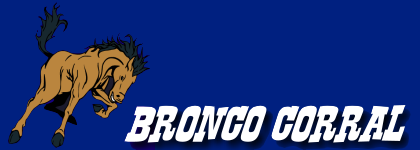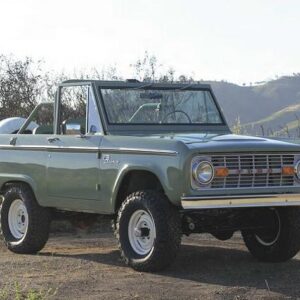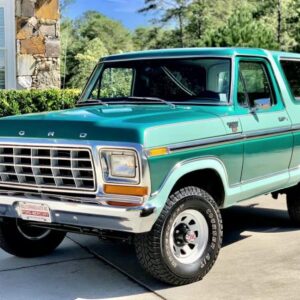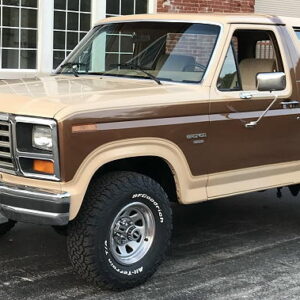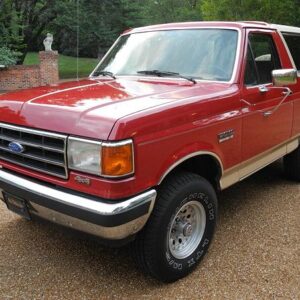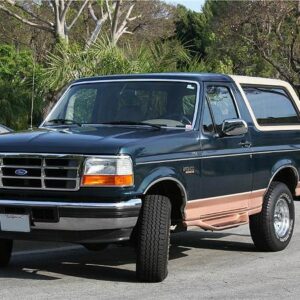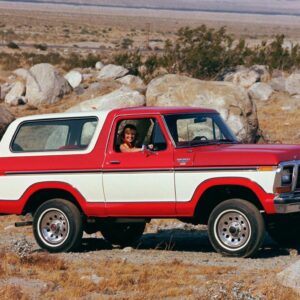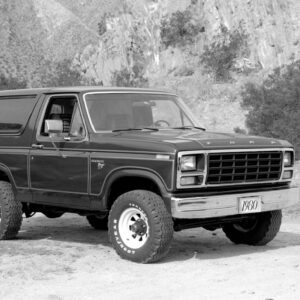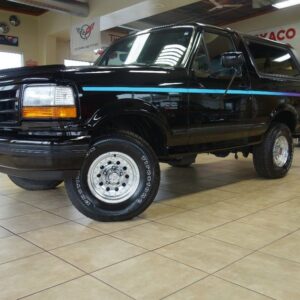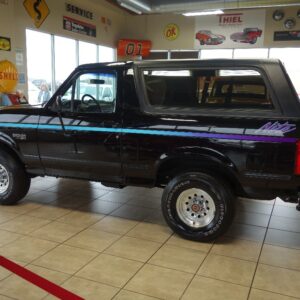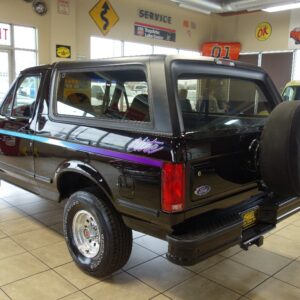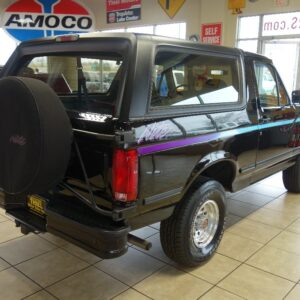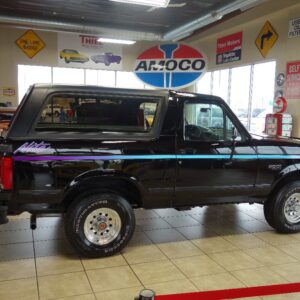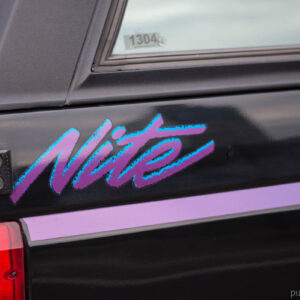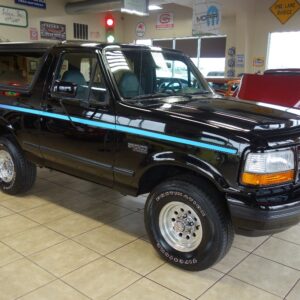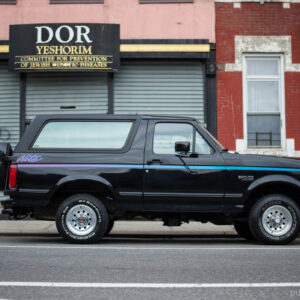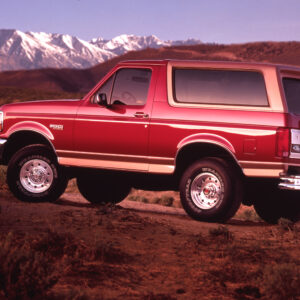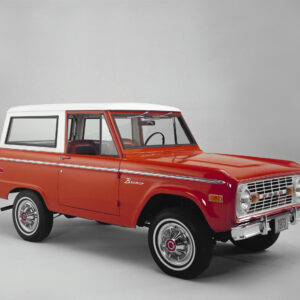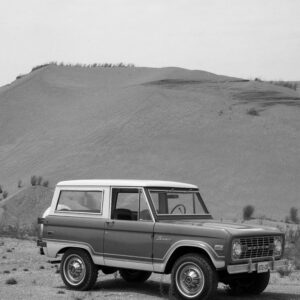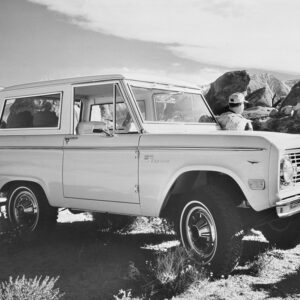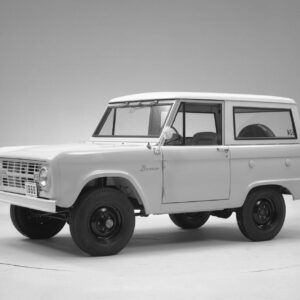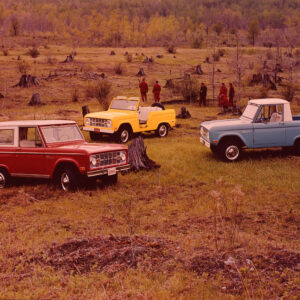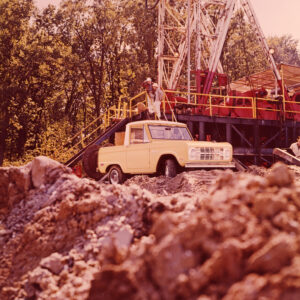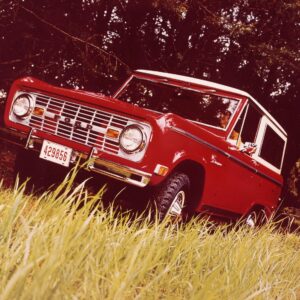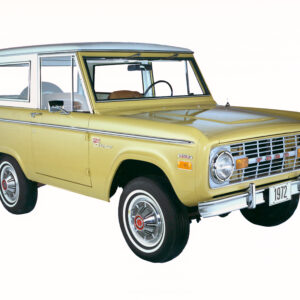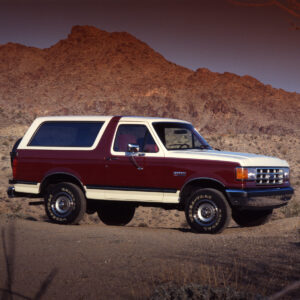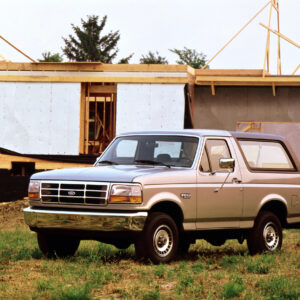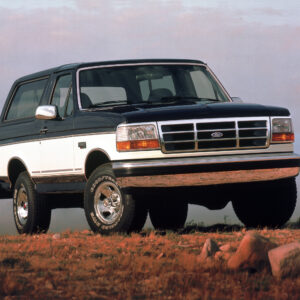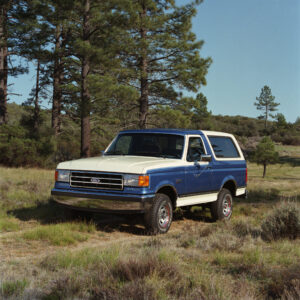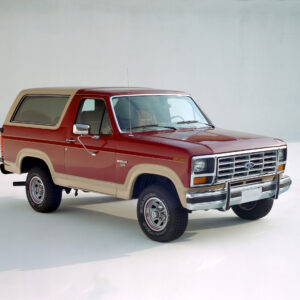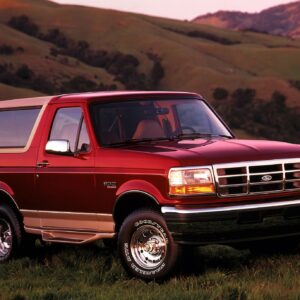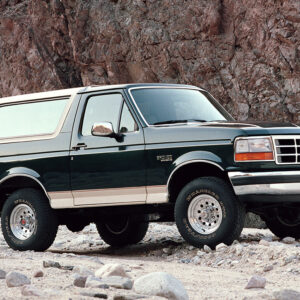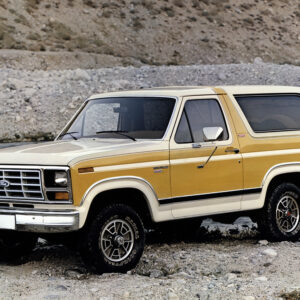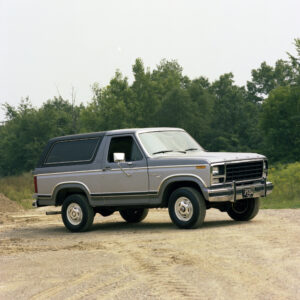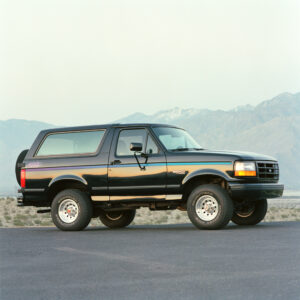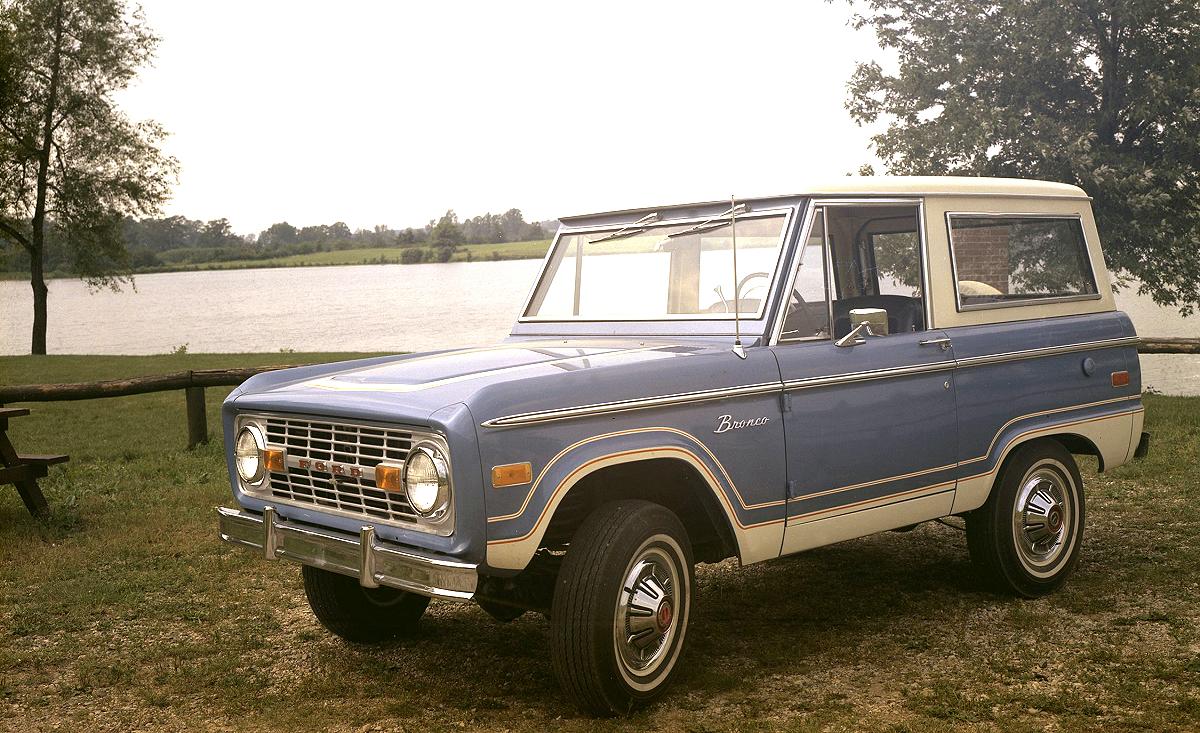
The original Bronco was an ORV (Off-Road Vehicle), intended to compete primarily with Jeep CJ models and the International Harvester Scout. The Bronco’s small size (92 in wheelbase) made it popular for off-roading and some other uses, but impractical for such things as towing.
The idea behind the Bronco began with Ford product manager Donald N. Frey, who also conceived of the Ford Mustang; and similarly, Lee Iacocca pushed the idea through into production. In many ways, the Bronco was a more original concept than the Mustang; whereas the Mustang was based upon the Ford Falcon, the Bronco had a frame, suspension, and body that were not shared with any other vehicle.
The Bronco was designed under engineer Paul G. Axelrad. Although the axles and brakes were sourced from the Ford F-100 four wheel drive pickup truck, the front axle was located by radius arms (from the frame near the rear of the transmission forward to the axle) and a lateral track bar, allowing the use of coil springs which gave the Bronco a tight (34 ft) turning circle, long wheel travel, and an anti-dive geometry which was useful for snowplowing. The rear suspension was more conventional, with leaf springs in a typical Hotchkiss design. A shift-on the-fly Dana Corp. transfer case and locking hubs were standard, and heavy-duty suspension was an option.
The initial engine was the Ford 170 cu in (2.8 L) straight-6, modified with solid valve lifters, a six-US-quart oil pan, heavy-duty fuel pump, oil-bath air cleaner, and a carburetor with a float bowl compensated against tilting.
Styling was subordinated to simplicity and economy, so all glass was flat, bumpers were simple C-sections, the frame was a simple box-section ladder, and the basic left and right door skins were identical except for mounting holes.
The early Broncos were offered in wagon, the ever popular halfcab, and less popular roadster configurations. Roadster was dropped early and the sport package, which later became a model line, was added.
The base price was only $2,194 (USD), but the long option list included front bucket seats, a rear bench seat, a tachometer, and a CB radio, as well as functional items such as a tow bar, an auxiliary gas tank, a power take-off, a snowplow, a winch, and a posthole digger. Aftermarket accessories included campers, overdrive units, and the usual array of wheels, tires, chassis, and engine parts for increased performance.
The Bronco sold well in its first year (23,776 units produced) and then remained in second place after the CJ-5 until the advent of the full-sized Chevrolet Blazer in 1969. The Blazer was a much larger and more powerful vehicle which could offer greater luxury, comfort, space, and a longer option list including an automatic transmission and power steering, and thus had broader appeal. Ford countered by enlarging the optional V8 engine from 289 cu in and 200 hp to 302 cu in and 205 hp, but this still could not match the Blazer’s optional 350 cu in and 255 hp (horsepower numbers are before horsepower ratings changed in the early to mid 70s. A 255hp engine would have a horsepower rating of roughly 170 by today’s standards.)
In 1973, power steering and automatic transmissions were made optional and sales spiked to 26,300, but by then, Blazer sales were double those of the Bronco, and International Harvester had seen the light and come out with the Scout II that was more in the Blazer class. By 1974, the larger and more comfortable vehicles such as the Cherokee made more sense for the average driver than the more rustically-oriented Bronco. The low sales of the Bronco (230,800 over twelve years) did not allow a large budget for upgrades, and it remained basically unchanged until the advent of the larger, more Blazer-like second generation Bronco in 1978. Production of the original model fell (14,546 units) in its last year, 1977.
Engine(s):
170 CID (2.8 L) 89 horsepower Straight-6 (1966-1972)
200 CID (3.3 L) 89 horsepower Straight-6 (1973-1974)
289 CID (4.7 L) 150 horsepower Windsor V8 (1966-1968)
302 CID (4.9 L) 137 horsepower Windsor V8 (1969-1977)
Transmission(s):
3-speed manual
3-speed automatic
Dimensions:
Wheelbase: 92 in
Length: 151.5 in
Width: 68.5 in
Height: 71.6 in
Ford Bronco Racing:
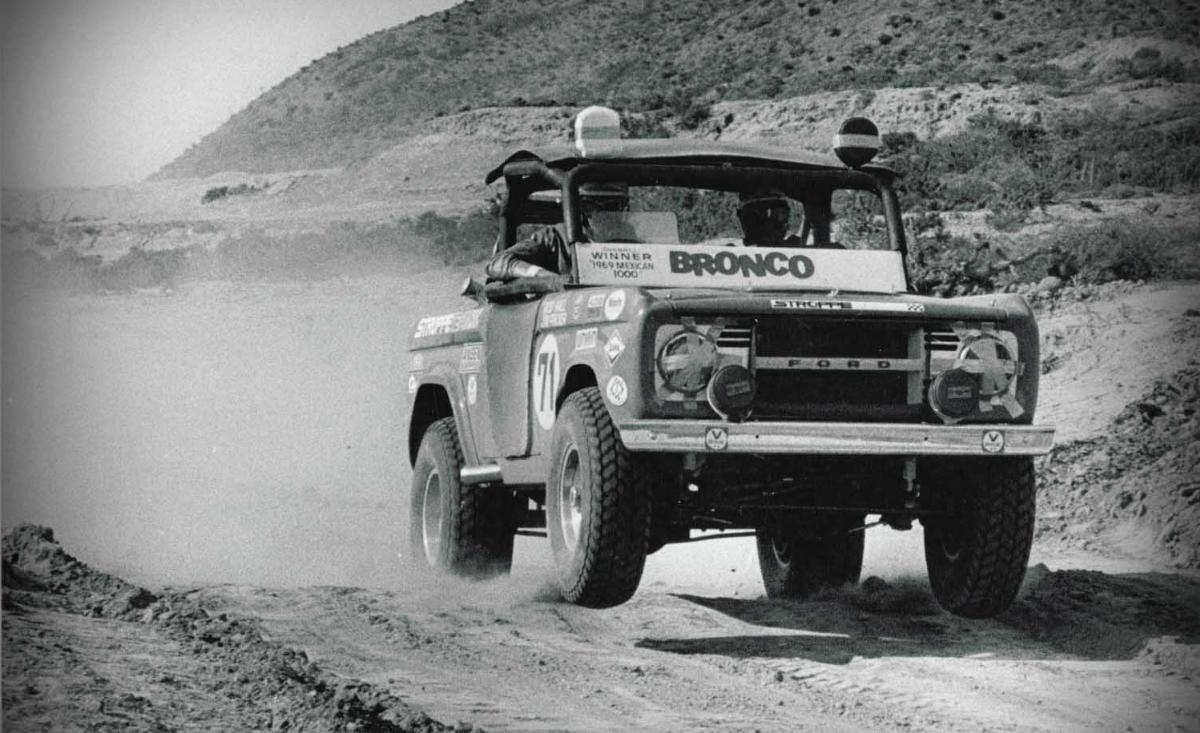
In 1965, racecar builder Bill Stroppe assembled a team of Broncos for long-distance off-road competition for Ford. Partnering with Ford’s frequently favored race team Holman-Moody, the Stroppe/Holman/Moody (SHM) Broncos proceeded to dominate the Mint 400, Baja 500, and Mexican 1000 (which was later named the Baja 1000). In 1969 SHM again entered a team of six Broncos in the Baja 1000. In 1971, a “Baja Bronco” package partially derived from Stroppe’s design was offered in the Ford showrooms, featuring quick-ratio power steering, automatic transmission, fender flares covering Gates Commando tires, a roll bar, reinforced bumpers, a padded steering wheel, and distinctive red, white, blue, and black paint. However, at a price of $5,566 (USD) versus the standard V8 Bronco price of $3,665, only 650 were sold over the next four years.
In 1966, a Bronco dragster built by Doug Nash ran the quarter mile in 9.2 seconds, with a top speed of 150 mph (240 km/h).
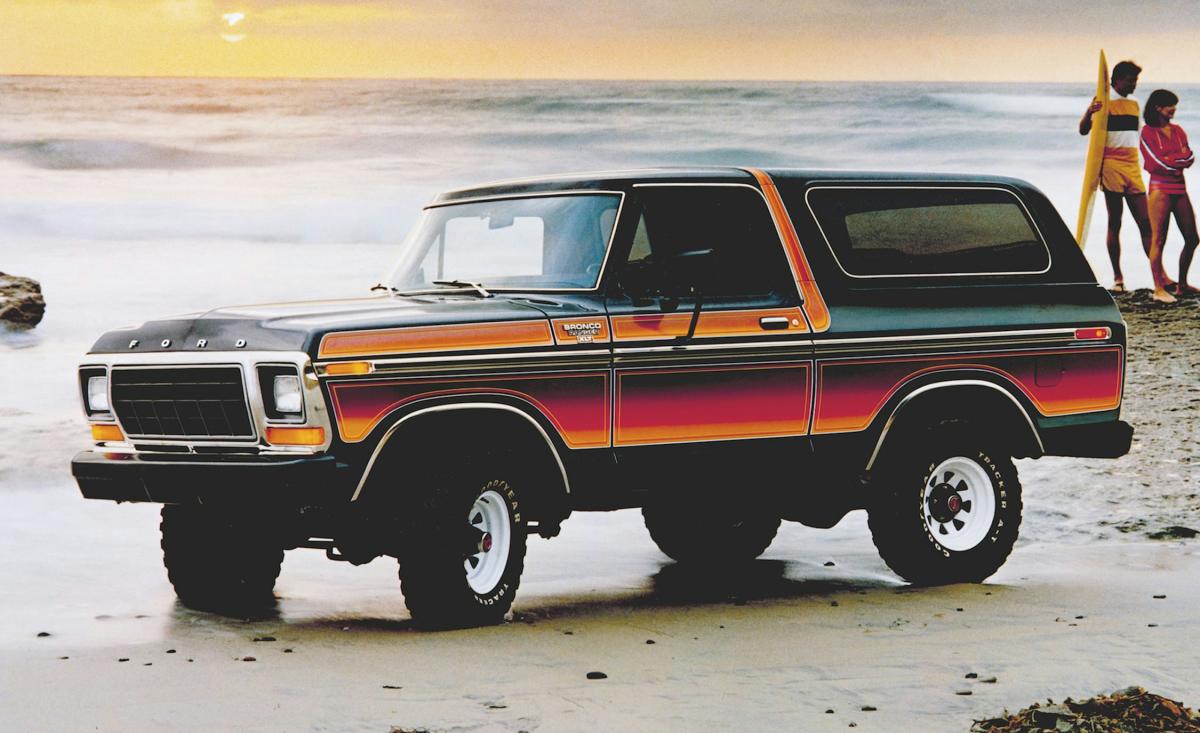
1978-1979 Ford Bronco (2nd Generation):
The redesign of the Bronco in 1978 was based on the F-100 truck, sharing many chassis, drivetrain, and body components. The entire front clip is indistinguishable from their full size trucks for those years, and 78/79 broncos were available in either round or square sealed beam headlight styles. Ford started the redesign in 1972, codenamed Project Short-Horn, but introduction was delayed by concerns over the mid-1970s fuel crisis. The increased size allowed them to compete with the fullsize SUVs offered by GM (Chevrolet Blazer/GMC Jimmy), Chrysler (Dodge Ramcharger/Plymouth Trailduster), American Motors (Jeep Grand Wagoneer), and Toyota (Toyota Land Cruiser). The base engine was a 351 cu in (5.8 L), with an optional 400 cu in (6.6 L). A Ford 9″ rear axle and a Dana 44 front axle were standard. 1979 saw the addition of a catalytic converter, and other various emissions control equipment.
The 78-79 Broncos are among the most popular fullsize Broncos due to their solid front axles, favored by most off roaders and many towers. The Bronco dropped the solid front axle for a “hybrid” independent front suspension (known as the Twin Traction Beam, or TTB) setup in 1980. All Broncos from 66-96 came with a solid rear axle.
Engine(s):
351 CID (5.8 L) 351M V8 156 hp / 262 lb-ft (1978)
351 CID (5.8 L) 351M V8 158 hp / 262 lb-ft (1979)
400 CID (6.6 L) 400 V8 158 hp / 277 lb-ft (1978)
400 CID (6.6 L) 400 V8 156 hp / 277 lb-ft (1979)
Transmission(s):
4-speed Borg-Warner T-18 manual
4-speed New Process NP435 manual
3-speed C6 automatic
Dimensions:
Wheelbase: 104 in
Length: 180.3 in
Width: 79.3 in
Height: 75.5 in
Curb Weight: 4,663–4,718 lb
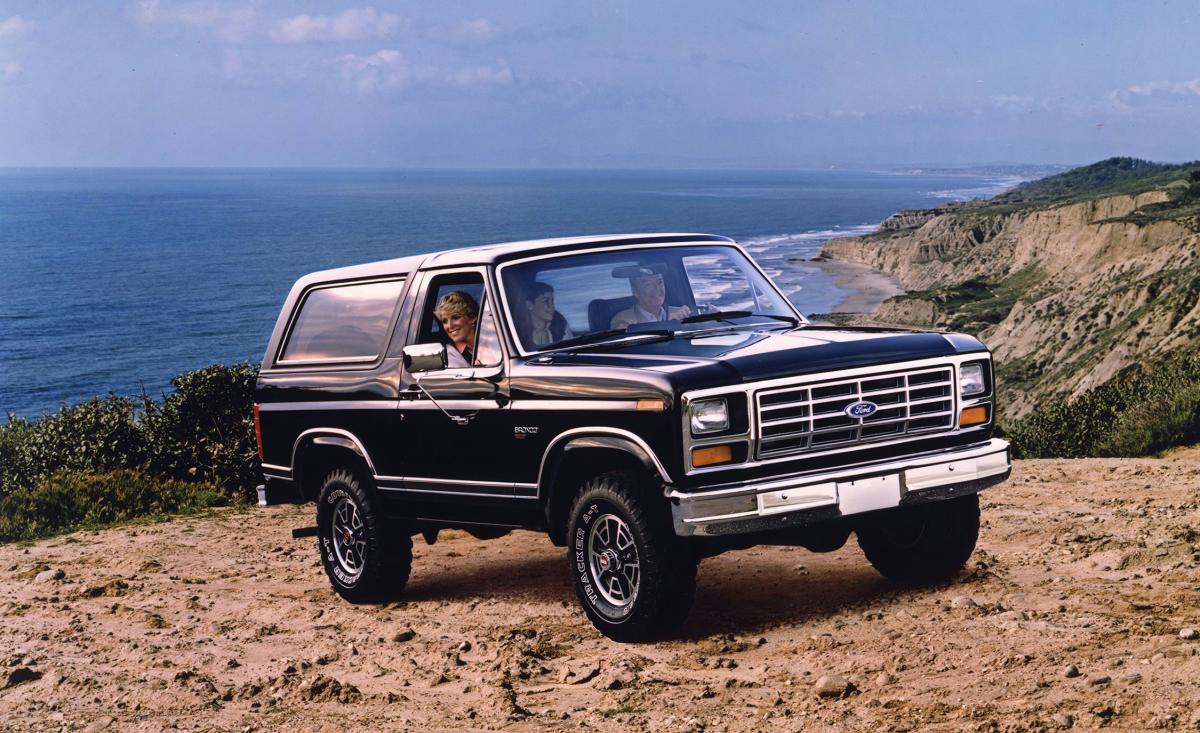
1980-1986 Ford Bronco (3rd Generation):
There was a major redesign of the model in 1980 (the 1980 model was based on the redesigned Ford F-Series; this generation lasted until 1986 with no sheetmetal changes, mostly powertrain and chassis related). The new Bronco was shorter, and had cosmetic changes along with powertrain, suspension and other odds and ends. Most notably, the Ford Bronco had a TTB (twin traction beam) setup in the front end for an independent front suspension. Many state that the TTB isn’t a true independent front suspension, nor is it a solid front axle, but a hybrid of the two with a “solid” axle that pivots around the differential and uses coil springs instead of leaf springs. The TTB system offered a higher degree of control and comfort both on and off road, but sacrificed wheel travel, and is notorious for being difficult to keep aligned.
With a smaller Bronco and fuel economy in mind, Ford offered a 300 cu in (4.9 L) straight six as the base engine. Although this engine came with more torque than the 302 cu in (4.9 L) V8 and comparable to the 351 cu in (5.8 L) V8 (until the High Output model), the engine was limited by a 1-bbl carburetor and restrictive single-out exhaust manifolds. Electronic emissions equipment added in 1984 further restricted the power of the inline six. Ford used up their remaining stock of 351M engines before switching over to the 351W in mid-model year 1982. A “High Output” version of the 351W became an option in 1984 and continued into the 1987 model year. Output was 210 hp at 4000 rpm vs the standard 2-bbl 351W which made 156 hp at 4000 rpm. The 302 was the first engine to receive electronic fuel-injection, starting in the 1985 model year.
Cosmetically, Ford returned to using its “blue oval” logo on the front of a slightly redesigned grille, and removed the “F O R D” letters from the hood in 1982. Towards the mid-80’s, an Eddie Bauer edition Bronco was offered, with a tan interior and tan outside trim. Classic square mirrors were dropped in 1986.
Engine(s):
300 cu in (4.9 L) 119 horsepower Straight-6
302 cu in (4.9 L) 137 horsepower 302 V8
351 cu in (5.8 L) 138 horsepower 351M V8 (1980-1982)
351 cu in (5.8 L) 156 horsepower Windsor V8
Transmission(s):
4-speed Borg-Warner T-18 manual
4-speed New Process NP435 manual
4-speed Tremec RTS OverDrive
3-speed C6 automatic
4-speed AOD
Dimensions:
Wheelbase: 104.0 in
Length: 180.3 in
Width: 79.3 in
Height: 75.5 in
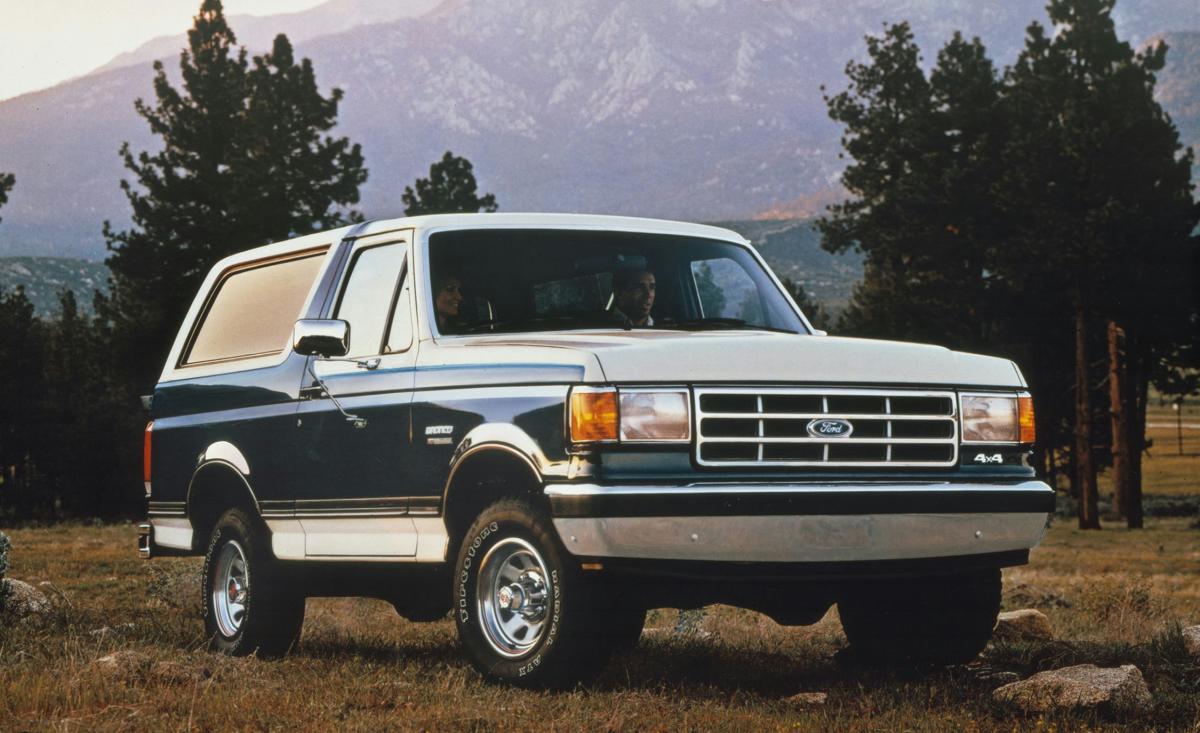
1987-1991 Ford Bronco (4th Generation)
In 1987, the body and drivetrain of the fullsize Bronco changed, as it was still based on the F-Series. The new aero body style reflected a larger redesign of many Ford vehicles for the new model year. By 1988, all Broncos were being sold with electronic fuel injection (first introduced in 1986 with the 302). In 1990, Ford started offering the heavy duty E4OD transmission.
Engine(s):
300 cu in (4.9 L) 140/150 horsepower Straight-6
302 cu in (4.9 L) 137 horsepower 302 V8
351 cu in (5.8 L) 210 horsepower Windsor V8
Transmission(s):
5-speed M5OD-R2 manual
3-speed C6 automatic
4-speed AOD automatic
4-speed E4OD automatic
Dimensions:
Wheelbase: 104.7 in
Length: 180.5 in
Width: 79.1 in
Height (1987-1989): 74.0 in
Height (1990-1991): 74.5 in
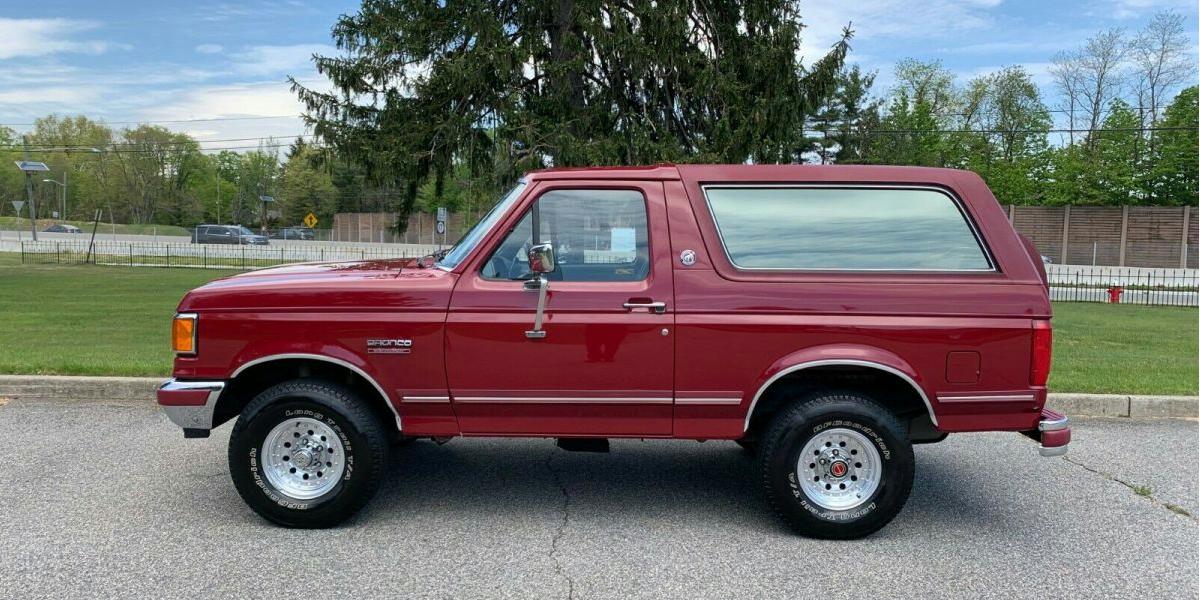
1991 Silver Anniversary Ford Bronco:
To commemorate 25 years of production, Ford offered a Silver Anniversary Edition Bronco for the 1991 model year.
The Silver Anniversary Edition featured Current Red exterior paint with a matching roof, and matching bumper and body side molding. The interior included gray leather seats with red accents (the first time leater seating was available for a Bronco), red carpeting, silver anniversary floor mats, and a silver anniversary dash badge. The exterior received special anniversary emblems on front fenders and rear cab pillar as well.
It’s estimated that 3,000 of these were built. Wouldn’t you have expected a silver anniversary edition to be silver?
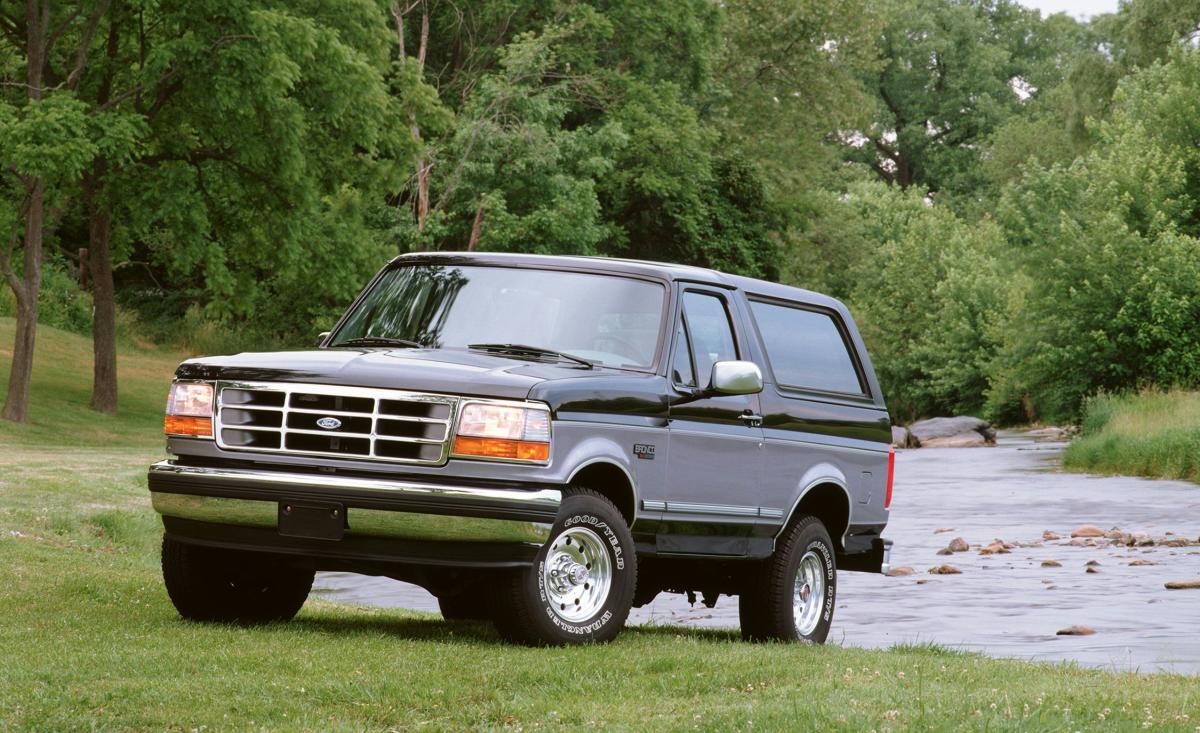
1992-1996 Ford Bronco (5th Generation):
The Bronco, along with the F-Series, was updated for 1992. The new Bronco was redesigned with safety in mind, incorporating front crumple zones, rear shoulder seat belts, a third brakelight embedded in the removable top, and after 1994, driver-side airbags. Due to the taillight and shoulder belts being safety equipment integrated into the top, the top was no longer legally removable and all literature in the owners manuals that had previously explained how to take the top off was removed. To further discourage its removal, the bolts securing the hardtop in place were changed to Torx “tamper proof” bolts, requiring special tools, in place of standard hex-head bolts. Cosmetic exterior and interior changes included a sweeping front end and a new dash. Power mirrors were also offered for the first time, and in 1996 the Bronco became the first vehicle to incorporate turn signal lights in the mirrors. No major drivetrain changes occurred.
In mid 1996, Ford officially made the decision to discontinue the Bronco. On Wednesday, June 12, 1996 the last Bronco ever built rolled off the assembly line at Michigan’s Ford Truck Plant. The last Bronco was escorted by Jeff Trapp’s 1970 Ford Bronco during a Drive-Off Ceremony. It was replaced by the Ford Expedition, which was introduced as the successor to the Bronco, and more effectively competed with GM’s Chevrolet Tahoe.
Engine(s):
300 cu in (4.9 L) 145/150 horsepower Straight-6 (1992)
302 cu in (4.9 L) 205 horsepower 302 V8
351 cu in (5.8 L) 210 horsepower Windsor V8
Transmission(s):
4-speed AOD-E automatic
4-speed E4OD automatic
5-speed M5OD-R2 manual
Dimensions:
Wheelbase: 104.7 in
Length: 183.6 in
Width: 79.1 in
Height (1995-1996): 74.4 in
Height (1992-1994): 74.5 in
Ford Bronco ‘Nite’:
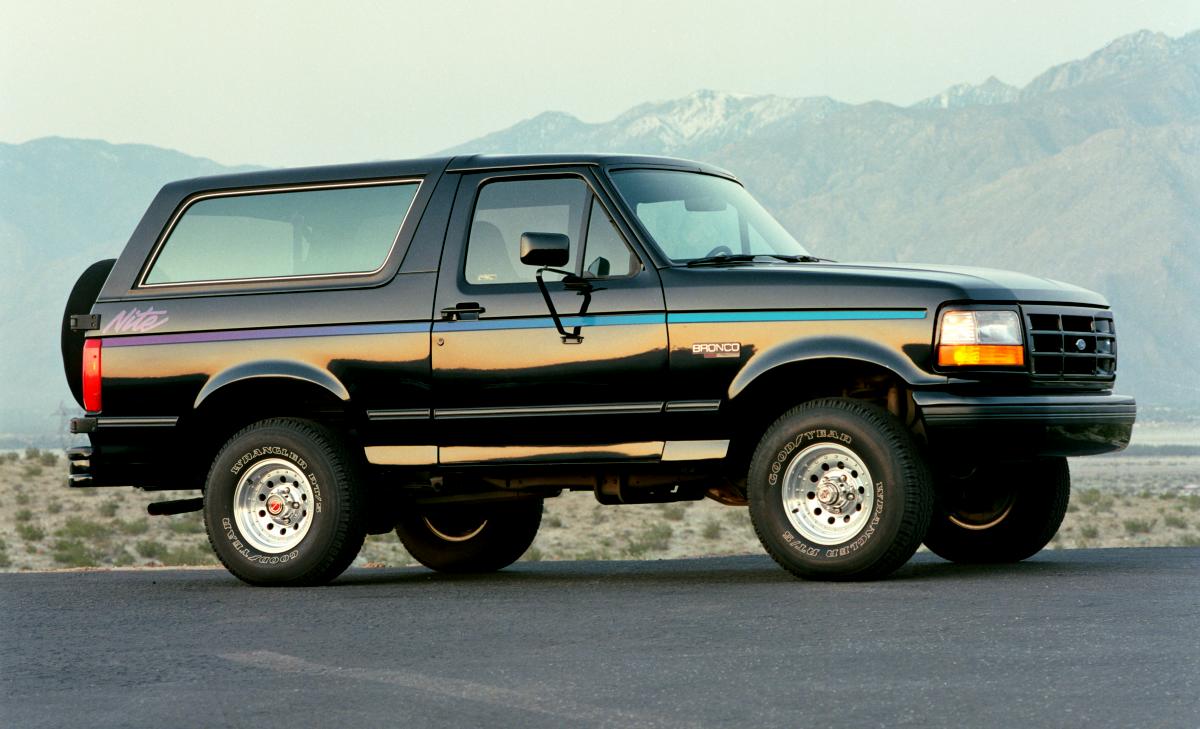
The “Nite” package was a special edition package that was available in 1991 and 1992 on the Ford F-150 and Bronco models. The package was for the most part an appearance package, with the most noticeable features being the Raven black paint & trim, and special multi color stripe and Nite decal on the sides and tailgate.
The Nite package also included 235/75/15 white-letter tires, forged aluminum deep-dish wheels, and sport suspension. The Nite Bronco also included a Nite logo on the rear spare tire cover.
These trucks came with either a 302 (5.0L) or 351 (5.8L) V8, and in either 2 wheel drive (2WD) or 4 wheel drive (4WD).
The Nite model interior includes a choice of colors – dark charcoal, scarlet red or crystal blue, a sliding rear window, ‘Nite’ nomenclature on the instrument panel and special ‘Nite’ floor mats.
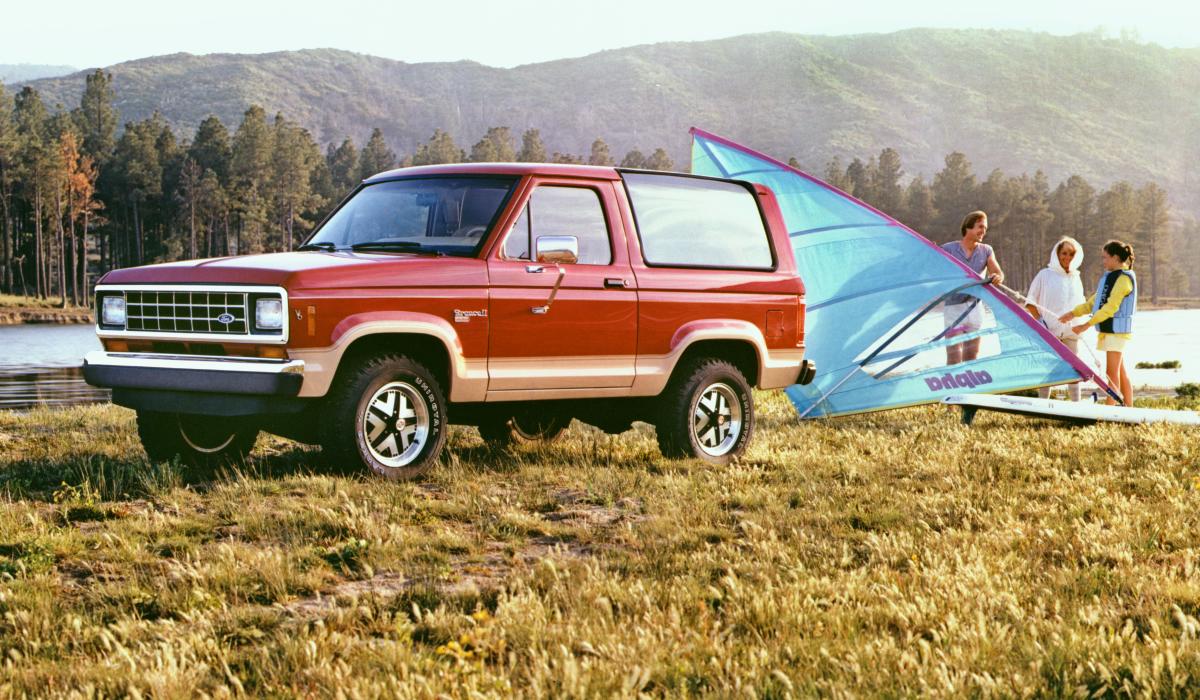
Ford Bronco II:
For the history of the 1984-1990 Ford Bronco II, check out the Ford Bronco II History Page.
More Ford Bronco Photos:
Click the photos to enlarge.
